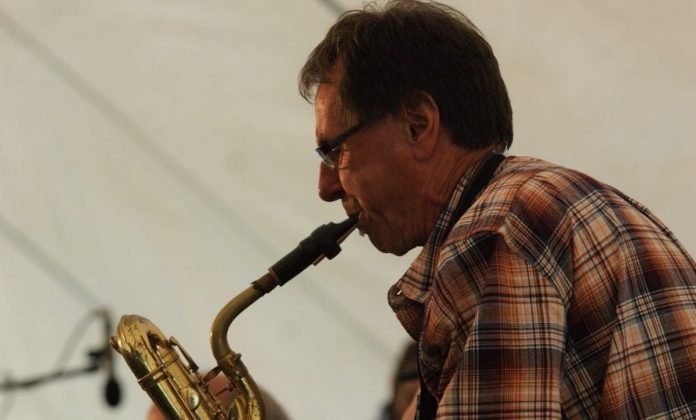Bruce Johnstone left Maynard Ferguson in 1976 and formed a jazz-fusion group called New York Mary with Rick Petrone, Lew Soloff and John Scofield. Their two albums on Arista Al 1019 and Al 1035 were “Hitpicks” in Billboard and Cashbox magazines. Then later that year he joined Woody Herman. An audition was unnecessary because the leader had heard him at festivals and was aware of his Downbeat poll ranking. Bruce did an extensive European tour with Herman which climaxed with a concert in West Berlin featuring Gerry Mulligan as guest soloist performing Take The A Train, Easy Living and Pound Cake.
On the band’s 1978 album Road Father, Bruce has an extensive feature on Sunrise Lady which he wrote and arranged for Woody. It’s an uptempo samba with a band-within-a- band concept with Birch Johnson (trombone), Dennis Dotson (trumpet) and Bruce carrying the engaging melody. He has a rare bass-clarinet outing on Pavane which demonstrates another, more lyrical, side of his musicality. Even more unusual is his tongue-in-cheek vocal contribution to I Got News For You – “You wore a diamond watch, you said it came from Uncle Joe. I looked at the inscription, it said love from Daddy-O!” (Century CJCD 829). Sleeve-note writer Herb Wong said “Bruce Johnstone is probably the strongest baritonist Woody has had in the last two decades”. Quite an accolade when you consider that Ronnie Cuber and Mike Brignola (no relation to Nick) had been in the band during that period.
‘Ben and Dexter both taught me the value of learning lyrics, how to play ballads and how to drive a rhythm section. Both were friends, teachers, mentors and my musical heroes. I’ve gained something from everyone I’ve ever played with. They remain a part of who I am’
“I liked Woody and he treated me well but I decided to leave in 1978. The money wasn’t great but I was able to live pretty well and even save some. We travelled by bus and I got to see a lot of the world while getting paid to do it. I approached it all as a tourist.” Trumpeter John Bennett, who was with Herman in the 60s, had a different view of the remuneration: “The pay was atrocious! You have to save up for these kinds of gigs.” Years ago I asked Gene Allen, who played baritone with the band in the 50s and 60s, what he thought of the Four Brothers voicing. “I liked it, although it was not much fun for the baritone because you are in the upper register a lot. I much prefer the conventional sax line-up where the baritone plays double-lead or has a contrapuntal role.” Bruce has no such reservations however: “I loved the tenor lead. As a section player I’m comfortable with whatever range the arranger puts me in.”
After leaving the band he got married and eventually settled in Ripley, a small country town on Lake Erie. He worked briefly with Clark Terry (“dear man and wonderful player”) and it was Terry who helped him obtain his Green Card which allowed him to live and work permanently in the USA. He wrote a “glowing recommendation” that helped impress the immigration service at his interview. The clerk told him that she used to dance to Woody Herman when she was in college and she asked if the band still played Woodchoppers Ball. Bruce assured her it was played every night. Woody himself once said, quite ruefully, “It was great the first 1000 times we played it!”
Bruce maintained a busy schedule of music clinics and concerts throughout the Western New York State, Pennsylvania and Ohio areas. On two occasions he was Artist In Residence at Penn State University and he has been the featured soloist with the Navy Commodores in Washington D.C. He often plays with the Buffalo Philharmonic along with Bobby Militello (“great player”), who had taken over from him in the Ferguson band. In 2001 he did a brief tour with the Mike Vax Big Band which featured Stan Kenton alumni although Bruce never actually played with Kenton. A CD celebrates the event which includes his own Sunrise Lady (Summit DCD 356). That was the year he became the Director of Jazz Studies at the State University of New York, a position he held until 2015. He organised big bands, small groups, string ensembles and vocal groups there and occasionally appeared in concert with artists like Teddy Charles and Arturo Sandoval.
In a recent communication Bruce explained his musical philosophy: “Ben and Dexter both taught me the value of learning lyrics, how to play ballads and how to drive a rhythm section. Both were friends, teachers, mentors and my musical heroes. I’ve gained something from everyone I’ve ever played with. They remain a part of who I am.”
I would like to thank my old friend Bruce Talbot for contacting his fellow New Zealander on my behalf. He is a fine tenor player and we played in numerous bands together in the mid-60s until he moved to America to take up a position with the Smithsonian. He is the author of Tom Talbert – His Life And Times (Scarecrow Press).
















